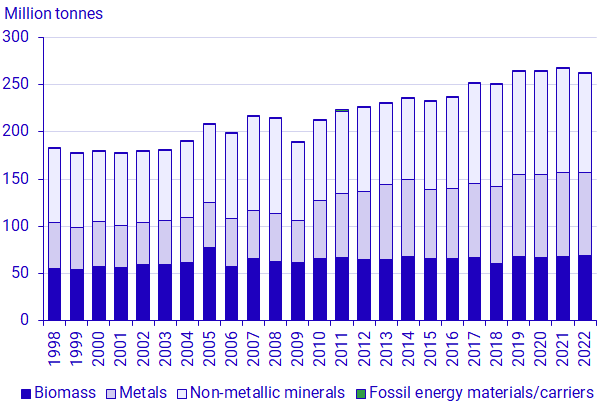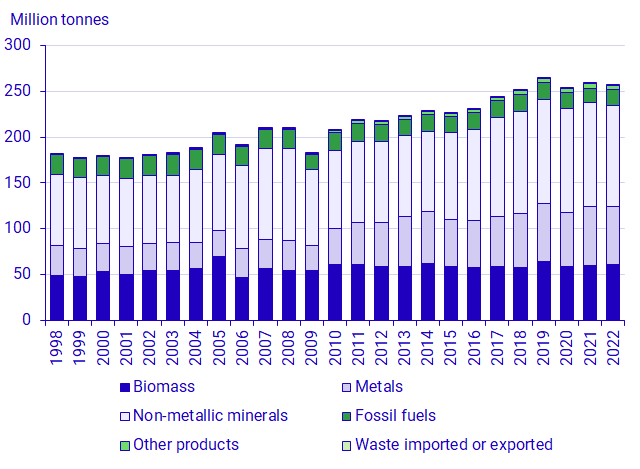Environmental accounts - Economy-wide material flow accounts 1998–2022
Reduced extraction of natural resources in 2022
Statistical news from Statistics Sweden 2024-01-24 8.00
After several years of a rising trend, domestic material consumption fell in 2022. In 2022, 262 million tonnes of natural resources were extracted in Sweden, which is a reduction of 2 percent since 2021. Domestic material consumption amounted to 24.5 tonnes per person in 2022 which is a reduction of 1 percent since 2021.
Domestic extraction
Large quantities of natural resources are extracted every year in Sweden for domestic use or export. In 2022, 262 million tonnes of natural resources were extracted, which is a clear decrease compared to 2021. The main reason is a reduced production of sand and gravel.
Non-metallic minerals is the largest material category, and accounted for 105 million tonnes in domestic extraction in 2022, of which sand and gravel accounted for 96 million tonnes. This is followed by extraction of metal ores, 87 million tonnes, where the most important among these metal ores were iron ore (39 million tonnes), copper ore (31 million tonnes), and gold and silver ore (12 million tonnes). Extraction of biomass amounted to 69 million tonnes, and consisted mainly of timber (41 million tonnes). This is the largest measured value of biomass since the storm Gudrun in 2005.
Certain events leave clear impressions in the statistics, such as the storm Gudrun, which led to a temporary large increase in timber extraction in 2005. The international financial crisis led to a sharp decline in most categories in 2009 due to falling demand. Furthermore, the severe drought in the summer of 2018 also left a clear impression, as crops of cereals, pulses, oilseed crops and straw failed, which led to a drop in biomass extraction.

Source: Environmental Accounts, Statistics Sweden
Domestic material consumption
Domestic material consumption is defined as domestic extraction plus imports minus exports. The domestic material consumption has decreased by 1 percent compared to 2021, and increased by 41 percent since 1998, to a total of 258 million tonnes in 2022.
The domestic material consumption of fossil fuels amounted to 18 million tonnes in 2022. This is an increase by 15 percent when compared to 2021, and a decrease by 21 percent since 1998. The consumption of non-metallic minerals, which is primarily sand and gravel, was 97 million tonnes in 2022. This is a decrease by 5 percent when compared to 2021, and an increase by 39 percent since 1998. The consumption of metals amounted to 64 million tonnes in 2022, which is a decrease by 2 percent when compared to 2021, and an increase by 92 percent since 1998.
Consumption of biomass amounted to 61 million tonnes in 2022, which is an increase by 2 percent when compared to 2021, and an increase by 25 percent since 1998.
The categories “Other products” and “Waste” have increased considerably since 1998, albeit from very low levels. In 2022, the consumption of “Other products” amounted to 5 million tonnes, and the consumption of “Waste” amounted to 1 million tonne.

Source: Environmental Accounts, Statistics Sweden
Material footprint
During the autumn of 2022, Statistics Sweden produced statistics regarding circular economy where material footprint, also known as raw material consumption (RMC), is included. An update of the data was made during 2023. Material footprint describes the amount of raw material used up streams in the complete production chain in Sweden and globally, as a result of the Swedish consumption (private consumption, public consumption and investments). More information is provided at Cirkular ekonomy (scb.se).
Definitions and explanations
The consumption of natural resources can be monitored in the system of economy-wide material flow accounts (EW-MFA), in the same way that GDP measures a country's revenues in monetary terms. One of the main indicators of the EW-MFA is domestic material consumption (DMC), which measures the amount of material extracted in the country, plus imports minus exports.
Material flows are divided into the following main material categories: biomass, metals, non-metallic minerals (mainly sand and gravel), fossil fuels, other products and waste. These are further divided into 40 subcategories.
The EW-MFA is used to measure the resource productivity of a country’s economy, and to examine the relationship between resource consumption and the GDP. For instance, the DMC indicator is used in the EU Roadmap to a Resource Efficient Europe.
Since 2013, the EW-MFA has been included in the EU regulation on environmental accounts, which means EU Member States are obliged to report statistics on their material flows to the EU.
Information on domestic extraction, imports and exports, and material consumption by material category is available in the Statistical Database. A file containing basic data and more figures is also available for download on the product page (link under “More about the results” at the top of this page).
Next publishing will be
The next publication is scheduled for 2025.
Statistical Database
More information is available in the Statistical Database
Feel free to use the facts from this statistical news but remember to state Source: Statistics Sweden.
